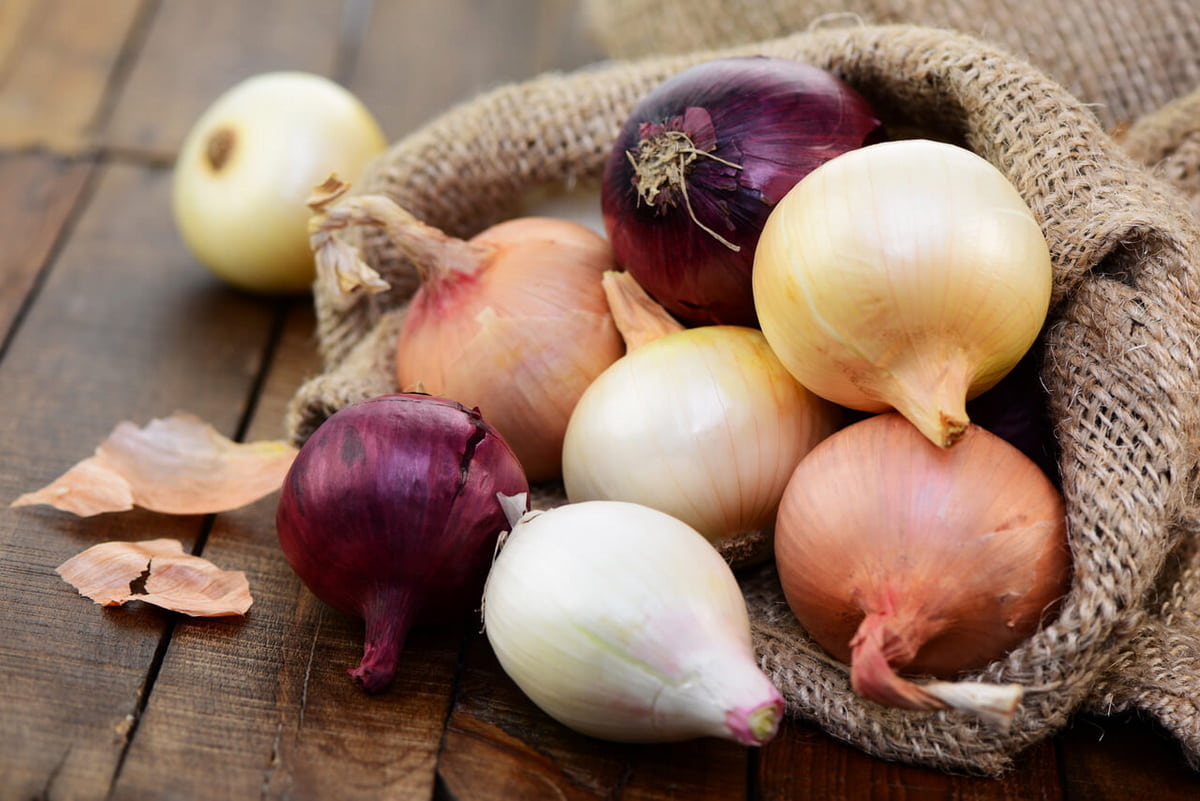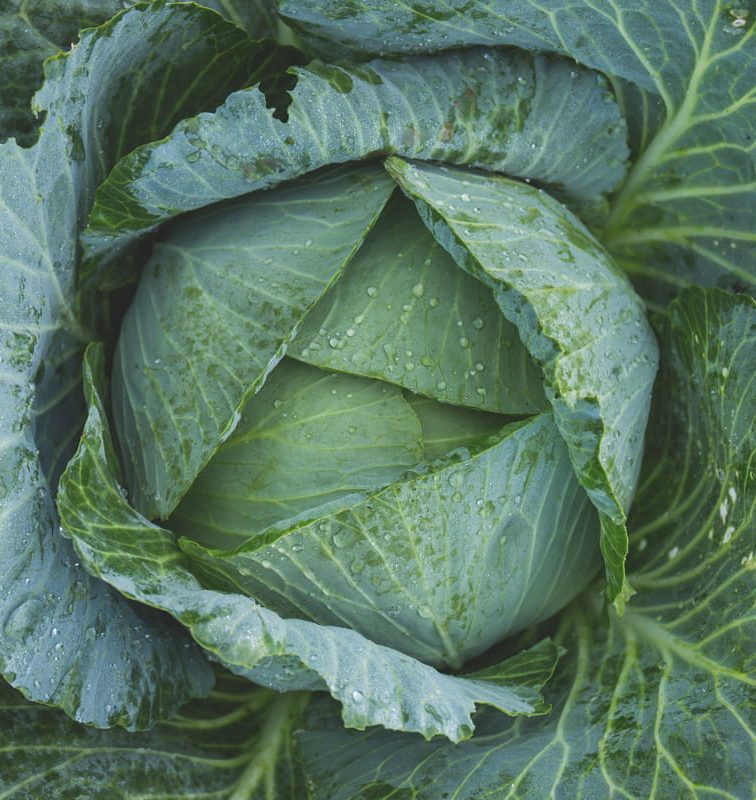Peeling back the layers of the humble onion reveals a wealth of intriguing stories that stretch from ancient civilizations to modern kitchens. From their revered status in Egyptian tombs to their unexpected role in Olympic preparation, onions have been more than just a culinary staple. These bulbous vegetables have been symbols of eternity, subjects of scientific curiosity, and even elements of cultural superstition.
Their rich history, combined with their nutritional prowess and culinary versatility, makes onions a subject ripe for exploration. Whether it’s their surprising health benefits, the science behind our teary chopping experiences, or their varied uses across cuisines worldwide, there’s much to uncover. As we delve into these fun facts about onions, get ready to view this everyday vegetable in a whole new light.
1. Origin of the Word “Onion”
The word “onion” has a layered history as rich and fascinating as the vegetable itself. Tracing back to the early 12th century, the term initially appeared in various forms such as “ungeon,” “oinyon,” and “unione,” stemming from Anglo-French and Old French origins. The Latin precursor, unio, meaning a single large pearl, highlights the onion’s unique structure, resembling a string of pearls or the unity found in its concentric layers.
This etymology not only reflects the onion’s physical appearance but also its significance in ancient culinary and medicinal practices.
2. Onions Have Been Cultivated for Over 5,000 Years
The cultivation of onions dates back over 5,000 years, marking them as one of humanity’s oldest known agricultural pursuits. Researchers have traced onion cultivation to regions in Asia around 5000 BC, with evidence of their growth in Ancient Egypt, India, and China.
This extensive history highlights onions’ crucial role in early diets and medicine, owing to their durability, ease of storage, and diverse culinary applications.
3. World Records: Fastest Time to Eat an Onion and the Largest Onion Ever Grown

Yusuke Yamaguchi eats onions in competition. Image: guinnessworldrecords.com
Yusuke Yamaguchi of Japan holds the record for the fastest time to eat a raw onion, a tear-inducing feat he achieved in just 29.56 seconds on December 31, 2013. This eye-watering accomplishment took place at Commode 56 Shopping Street in Sumoto, Hyogo, Japan, during an end-of-year countdown party. The previous record was also set at the same venue, underscoring its significance in the world of competitive eating.
Moving from the world of speed to size, the record for the largest onion ever grown is held by Bob Blumer of Canada. He achieved this by peeling 50 pounds (22.68 kg) of onions in 2 minutes and 39 seconds on July 18, 2010, at the Walla Walla Sweet Onion Festival in Walla Walla, Washington, USA. This record not only tests the speed and skill of the peeler but also celebrates the agricultural achievement of growing such sizable onion.
4. Global Production: Over 106 Million Tons Produced Annually, with India Leading
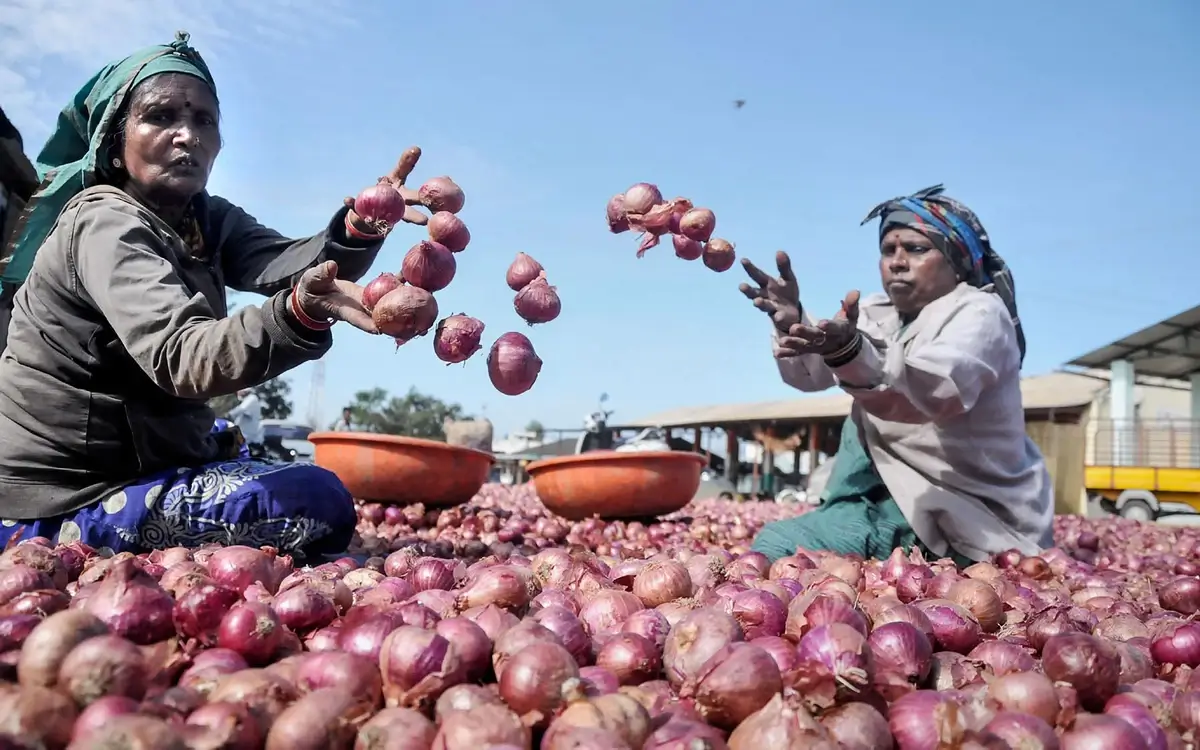
Image: telegraphindia.com
The global production of onions stands as a testament to its significance in diets worldwide, with an annual yield surpassing 106 million tons. This colossal figure highlights the onion’s staple status across various cuisines and its adaptability to diverse agricultural conditions.
India emerges as the leading producer, contributing a substantial portion to the global output, closely followed by China, which has dedicated millions of acres exclusively for onion cultivation. These two countries alone account for a significant share of the world’s total production, underscoring their pivotal role in the onion market. The United States, Egypt, and Turkey also contribute sizably, each with unique cultural ties to this versatile crop.
5. Syn-Propanethial-S-oxide is Responsible for Tears When Chopping Onions
When you chop onions, a chemical reaction unfolds that brings tears to your eyes. The key player in this process is syn-Propanethial-S-oxide, a volatile compound produced when the onion’s cells are damaged.
Initially, slicing an onion causes its enzymes to convert amino acids into sulfenic acid, which then quickly rearranges into syn-Propanethial-S-oxide. Once this compound wafts into your eyes, it irritates the lachrymal glands, prompting them to produce tears to dilute and flush it out.
6. Breath Freshening Qualities of Raw Onions
While onions are often blamed for causing bad breath, it’s interesting to note that they possess properties that could counteract this effect. Although the idea that raw onions can freshen breath might seem counterintuitive due to their strong aroma, it’s the antibacterial properties within onions that are believed to contribute to oral health.
Research and nutritional analyses suggest that onions contain compounds like sulfur and quercetin, which can offer several health benefits. Sulfur compounds, while responsible for the distinct smell of onions, also have antibacterial qualities that could potentially reduce bacteria in the mouth responsible for bad breath. Similarly, quercetin, an antioxidant found abundantly in onions, has been shown to fight bacteria, among its other health benefits. These properties might not directly translate to fresher breath immediately after consumption, but they contribute to the overall antibacterial environment in the mouth over time.
Moreover, consistent consumption of raw onions could improve oral hygiene due to their nutrient profile, including vitamins, minerals, and antioxidants, which support overall health, potentially reducing the prevalence of bacteria causing bad breath. However, it’s worth noting that the immediate after-effect of consuming raw onions can be strong-smelling breath, which is why some sources recommend chewing mint or parsley afterwards to mitigate this effect.
7. Onions’ Remarkable Soil Versatility
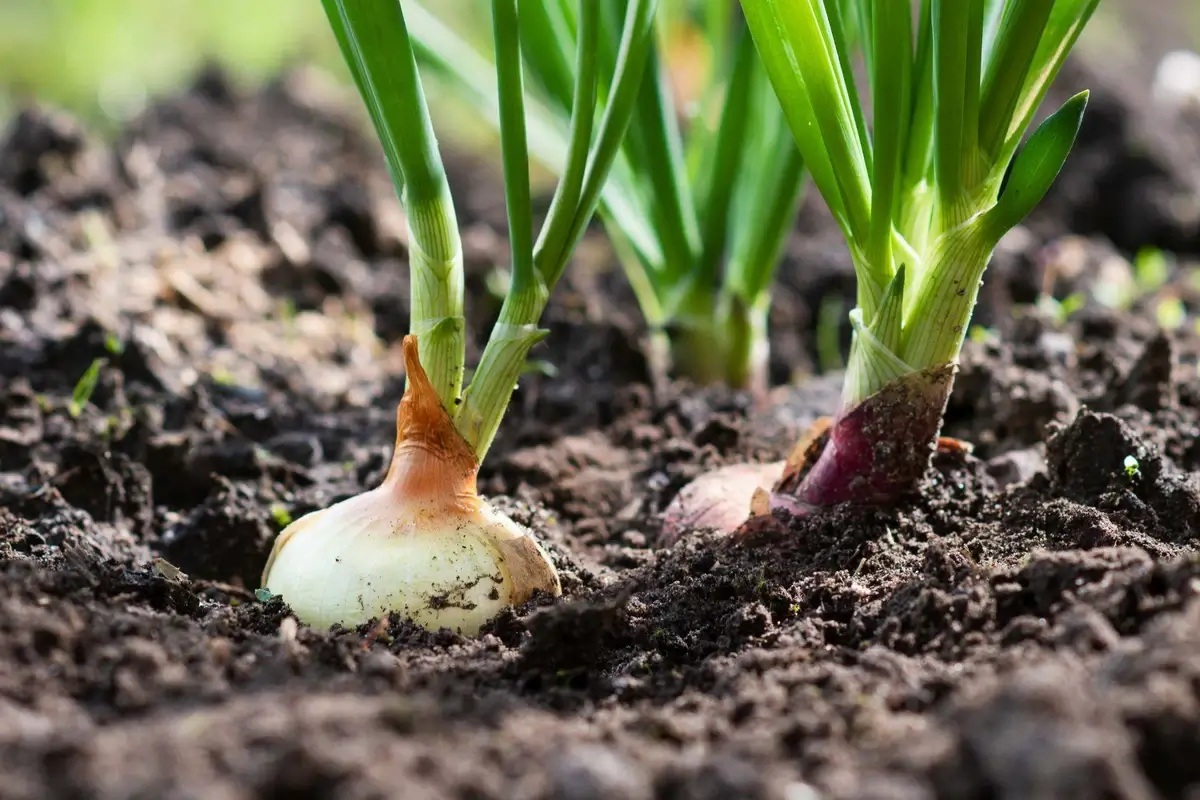
Image: smcloud.net
Onions are a resilient and adaptable crop, thriving across a myriad of soil types, from sandy loams to heavy clay. Their ability to adapt is grounded in their robust root systems and minimal soil nutrient requirements, although they flourish best in well-drained, fertile soils with a pH range of 6.0 to 7.5.
Key to their successful cultivation across various soils is the balance of soil fertility and moisture levels. Sandy soils, known for their excellent drainage, support the rapid development of onion bulbs but require more frequent irrigation and fertilization to compensate for lower water and nutrient retention. On the other hand, clay soils, with their high nutrient and moisture-holding capacities, may need improved drainage to prevent waterlogging and ensure healthy growth.
Optimal Soil Types for Onions:
- Sandy Loam: Ideal for quick bulb development, offering excellent drainage and easy root penetration.
- Loamy Sand: Requires more irrigation but provides good aeration and minimal resistance to expanding bulbs.
- Silt Loam: Balances moisture retention and drainage, supporting consistent growth.
- Clay Loam: Rich in nutrients with higher water retention, suitable for onions when drainage is managed effectively.
Adjustments in cultural practices, such as raised beds or irrigation management, can further enhance onion growth in less than ideal soil conditions. It’s this adaptability that allows onions to be a staple crop in diverse agricultural settings globally.
8. Daylight Sensitivity in Onions: Influencing Bulb Formation
Onions are highly sensitive to daylight, with their bulbing process directly influenced by the amount of daily sunlight they receive. This unique characteristic categorizes onion varieties into three main groups based on their daylight requirements: long-day, intermediate-day, and short-day onions.
- Long-Day Onions thrive in northern latitudes (37–47°), initiating bulb formation with 14–16 hours of daylight. They are typically planted in late winter to early spring.
- Intermediate-Day Onions require 12–14 hours of daylight and are suitable for areas in the middle latitudes.
- Short-Day Onions need 10–12 hours of daylight to start bulbing, making them ideal for southern regions.
The daylight length not only triggers the start of the bulbing process but also influences the overall size and quality of the onion bulbs. It’s essential for gardeners to select the appropriate variety for their geographic location to ensure optimal growth and bulb development. Understanding the specific daylight needs of each onion type can help in achieving the desired yield, with bulbing dependent on daylength and temperature, rather than the size or age of the plant.
9. Family Relations: The Allium Connection
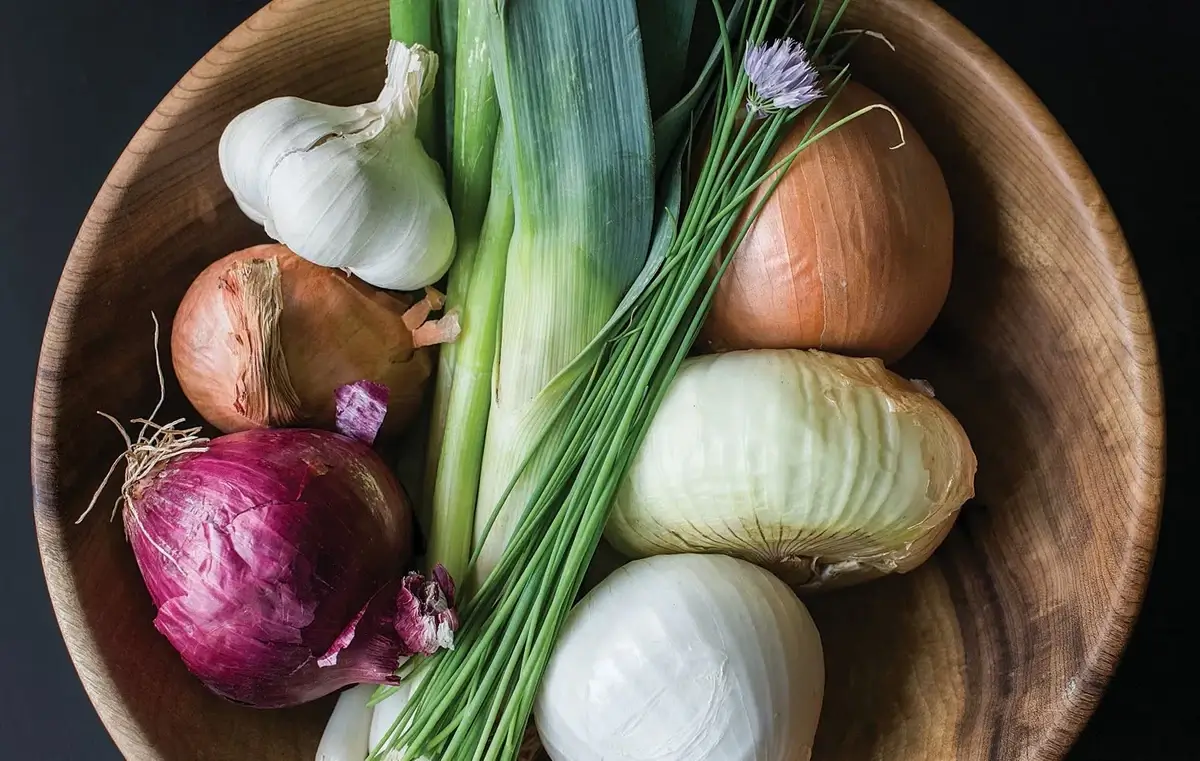
Image: wp.com
Onions, alongside garlic, leeks, chives, shallots, and scallions, form a closely knit family known as the Allium genus. This group is distinguished by its fundamental characteristics, such as the formation of bulbs and a distinctive flavor profile that ranges from sharp and spicy to mild and sweet, depending on the variety. Each member of this family carries its unique culinary applications and health benefits, contributing to their widespread use across various cuisines globally.
Shallots, often termed the “multiplier onion,” oscillate between being classified as a distinct species or a type of onion, depending on cultural perspectives. They are known for their mild, sweet flavor, making them a favorite in fine cooking. Leeks, with their long, bundled leaf sheaths, offer a milder, onion-like taste and are commonly used in soups and broths in European cuisine. Scallions, or spring onions, lack a full bulb and are utilized for their green shoots, adding a fresh, mild flavor to dishes.
Garlic stands out for its robust flavor and numerous health benefits, with its cloves being a staple in both culinary and medicinal applications. Chives, the smallest members of the Allium family, are valued for their delicate, onion-like flavor, often used as a garnish or seasoning in various dishes.
Each of these Allium family members shares the characteristic of being highly versatile in the kitchen, enriching dishes with their unique flavors and nutritional profiles. Their common ancestry underlines the interconnectedness of food and culture, highlighting the diversity within a single plant family.
10. Onions Can Remove Rust from Knives
Believe it or not, your kitchen onion does more than just add flavor to dishes or bring tears to your eyes. It possesses the ability to clean rust off your knives, a hack that leans into the more unusual applications of common household items. The science behind this trick lies in the onion’s natural juice, which, when a knife is plunged into it multiple times, helps dissolve the rust.
This method is straightforward and requires no special tools or harsh chemicals, making it an eco-friendly alternative to traditional rust removal techniques. If you’re dealing with a particularly stubborn rust issue, you may need to give your knife a few extra jabs into the onion to see results.
11. The Largest Onion Ever Grown Weighed Over 19 Pounds

Gareth Griffin’s record-breaking onion. Image: bbc.com
The title for the heaviest onion ever grown goes to a colossal specimen that tipped the scales at an astonishing 8.97 kg (19 lb 12.4 oz). This giant was nurtured by Gareth Griffin, a dedicated gardener from the UK, who presented his prodigious allium at the Harrogate Autumn Flower Show in North Yorkshire, UK, on 15 September 2023.
Griffin’s achievement shattered the previous record, marking a new high in the annals of onion cultivation.
12. People Worldwide Eat an Average of 13.7 Pounds of Onions Annually
Globally, onions are a staple ingredient in numerous cuisines, evidencing their universal appeal and culinary versatility. On average, individuals consume about 13.7 pounds of onions each year.
This statistic reflects onions’ significance across various diets and cultures, serving as a fundamental component in dishes ranging from savory soups to flavorful garnishes.
13. Properly Stored Onions Can Last Several Months
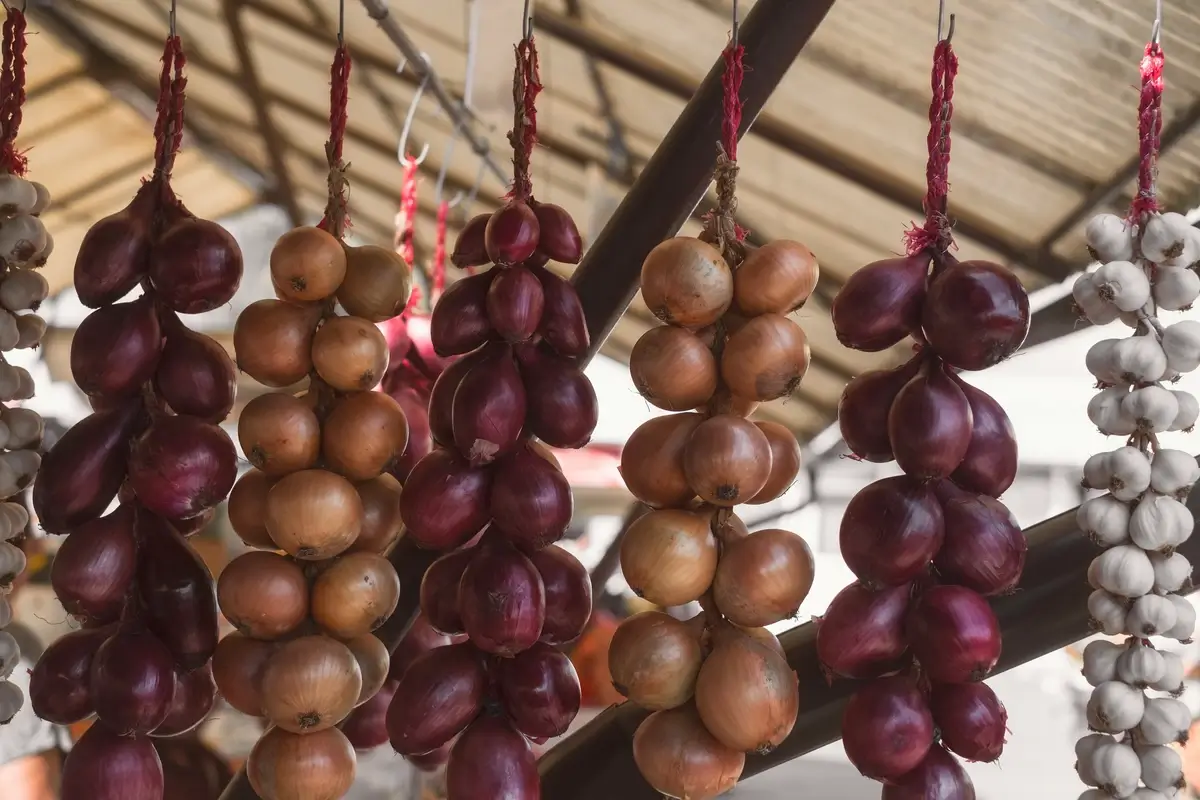
Image: homesandgardens.com
Onions boast a remarkable shelf life when stored under ideal conditions, making them a durable staple in kitchens worldwide. Whole, uncut onions can last two to three months if kept in a cool, dry place. This longevity is attributed to onions’ natural composition, which allows them to resist spoiling when the environment is free of excessive moisture and heat.
The key to maximizing an onion’s shelf life involves storing them in a well-ventilated area away from direct sunlight. Locations such as cellars, pantries, or garages that maintain a steady temperature and low humidity are ideal. This storage wisdom not only preserves the onions’ freshness but also ensures their nutritional value and taste remain intact over time, ready to enhance a wide array of dishes.
14. Onion Can Be Used as a Repellent
Onions, along with their Allium family counterparts such as garlic and chives, are recognized for their effectiveness in repelling pests from gardens and homes due to their strong scent. This is primarily attributed to the compound allyl-epropyl-disulfide, which acts as a natural deterrent against a wide array of insects by emitting a potent odor that is unpalatable to pests. This odor not only repels insects but can also mask the scents of other plants, making them less attractive to pests.
In gardening contexts, onions can be strategically planted alongside other crops to shield them from pests such as aphids, mealybugs, and caterpillars. This companion planting approach can significantly reduce pest infestations without the need for chemical pesticides, thus promoting a more organic and sustainable gardening practice. An added benefit of using onions for pest control is their contribution to soil enrichment, providing essential nutrients to plants.
For home pest control, onions can be used to create barriers or repellents. Chopped onions can be soaked in water to create a sprayable solution that, when applied to plants, helps keep pests at bay. This method is not only effective but also eco-friendly, offering a chemical-free alternative to conventional pest repellents.
Overall, incorporating onions into pest management strategies can be a cost-effective and environmentally friendly way to maintain healthy and thriving gardens and homes. By utilizing onions’ natural pest-repellent properties, gardeners and homeowners can enjoy the dual benefits of pest control and soil enrichment, all while adhering to organic gardening principles.
15. White Onions Are the Most Pungent, While Sweet Onions Are Known for Their Mild Flavor
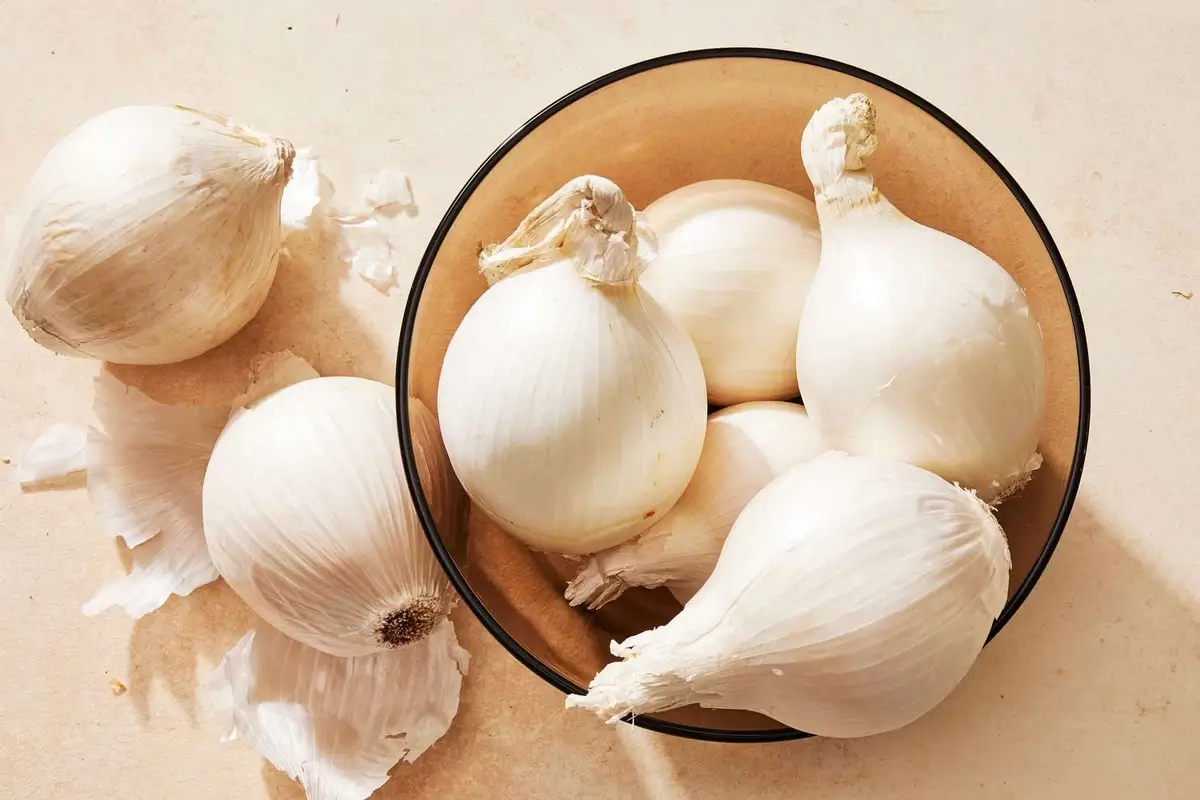
White onions are the most pungent. Image: southernliving.com
The diversity among onion varieties is vast, with each type offering unique flavors and uses in cooking. Among these, white onions and sweet onions stand out for their distinct characteristics. White onions are recognized for their sharpness and intensity, making them a preferred choice for dishes that benefit from a strong onion flavor. This variety is particularly favored in raw applications, such as in salsas and salads, where their crispness and pungency can shine.
Conversely, sweet onions, such as the Vidalia, Walla Walla, and Maui varieties, are celebrated for their mildness and high sugar content. These onions lack the sharp bite of their white counterparts, making them ideal for caramelizing or adding a subtle sweetness to dishes. Sweet onions’ gentle flavor is less overpowering, allowing them to complement rather than dominate the taste profile of meals.
The difference in pungency between white and sweet onions is attributed to their sulfur content, which impacts their flavor intensity. White onions, with their higher sulfur content, offer a more potent taste, whereas sweet onions, with lower sulfur levels, provide a softer, more palatable flavor suitable for a wider range of culinary applications.
16. Seasonal Availability of Onions: From Fresh to Storage
Onions, a versatile and essential kitchen staple, are distinguished not just by their varieties but also by their seasonal availability. Understanding this can enhance both the flavor and nutritional content of your meals.
Spring/Summer Onions: These onions grace the markets from March through August. Characterized by their thin, lighter-colored skin, they have a higher water content, making them more susceptible to bruising. This also means they have a shorter shelf life, usually around 30-60 days. Their flavor profile ranges from sweet to mild, ideal for raw consumption, pickling, or light cooking.
Fall/Winter Onions: As we transition into the cooler months, from August through May, onions with multiple layers of thick, darker colored skin become prevalent. These varieties are lower in water content, which extends their shelf life and makes them less prone to bruising. They range from mild to pungent in flavor, making them perfect for dishes that require longer cooking times, such as caramelized or roasted onions.
This seasonal shift not only impacts the texture and flavor but also how onions can be best utilized in cooking. Spring/Summer onions, with their sweet to mild flavors, are best suited for salads, sandwiches, and fresh dishes. On the other hand, the more pungent Fall/Winter onions are ideal for savory dishes, adding depth and richness to the meal.
17. Pesticide Considerations: Onions and the “Clean 15”
According to the Environmental Working Group (EWG), onions are part of the esteemed “Clean 15” list for 2023, a designation for fruits and vegetables with the lowest pesticide residues when grown conventionally. This list is particularly helpful for consumers seeking to minimize their exposure to pesticides without exclusively shopping for organic produce.
Despite their low pesticide residue, the cultivation of onions, like all agricultural practices, can involve pesticide use to protect crops from pests and diseases. However, the nature of onion farming and possibly the inherent properties of the onions themselves contribute to their low residue levels. This doesn’t imply that onions are grown without any pesticides but indicates that the levels found on them post-harvest are minimal, making them safer from a pesticide residue perspective.
Why This Matters
Choosing produce from the “Clean 15” can be especially important for individuals looking to reduce their pesticide intake due to health concerns. Pesticides have been linked to a range of health issues, from acute poisoning to long-term effects such as endocrine disruption, reproductive harm, and even cancer. For vulnerable populations, including pregnant women, infants, and children, minimizing pesticide exposure is even more crucial due to the potential for adverse developmental impacts.
FAQ
How old are onions?
Onions have been cultivated for over 5,000 years. Archaeological and written records suggest their use by various ancient civilizations, including the Egyptians, Babylonians, Greeks, and Romans, primarily for culinary, medicinal, and religious purposes.
Why are they called onions?
The term “onion” derives from the Latin word “unio,” which means “single” or “one,” reflecting the onion’s single bulb formation. This term evolved through the Old French “oignon” and Middle English “unyun” to the modern English “onion.”
What are 3 uses for onions?
- Culinary Use: Onions are a fundamental ingredient in many dishes worldwide, offering flavor, aroma, and sweetness. They are used in raw salads, sautéed as a base for sauces, soups, and stews, and caramelized for toppings.
- Medicinal Use: Historically, onions have been used for their therapeutic properties, including antiseptic, antibacterial, and anti-inflammatory effects. They are believed to help reduce the risk of heart disease and boost immune function.
- Preservative Use: Onions contain natural antimicrobial compounds that help preserve food. In traditional cooking, they are often used to extend the shelf life of dishes and prevent bacterial growth.
How many onions are eaten each year?
Globally, it’s estimated that over 105 billion pounds of onions are consumed each year. This figure underscores the vegetable’s popularity and essential role in cuisines around the world.
How many names of onions are there?
There are numerous varieties and names for onions, categorized mainly by color (red, white, and yellow), size, and flavor profiles. Beyond these basic categories, specific cultivar names exceed a hundred, including Vidalia, Shallot, Scallion, and Pearl onions, among others.
What is the healthiest onion to eat?
Red onions are often considered the healthiest choice among the different types of onions due to their higher content of antioxidants, particularly anthocyanins and quercetin. These compounds are known for their anti-inflammatory, antiviral, and anticancer properties.
Why is onion a superfood?
Onions are deemed a superfood because they are rich in vitamins (notably vitamin C), minerals, and potent plant compounds. These include flavonoids and sulfur-containing antioxidants, which contribute to a wide range of health benefits, including improved heart health, reduced inflammation, and enhanced immune function. Their low calorie yet high nutrient profile supports overall health and disease prevention.


